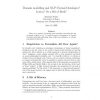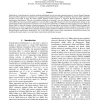126 search results - page 7 / 26 » The Use of NLP Techniques in CLIR |
AO
2005
13 years 7 months ago
2005
There are a number of genuinely open questions concerning the use of domain models in nlp. It would be great if contributors to Applied Ontology could help addressing them rather ...
LREC
2010
13 years 9 months ago
2010
Identification of transliterations is aimed at enriching multilingual lexicons and improving performance in various Natural Language Processing (NLP) applications including Cross ...
COLING
1996
13 years 9 months ago
1996
Porting a Natural Language Processing (NLP) system to a new domain remains one of the bottlenecks in syntactic parsing, because of the amount of effort required to fix gaps in the...
HICSS
2003
IEEE
14 years 1 months ago
2003
IEEE
Bilingual term lists are extensively used as a resource for dictionary-based Cross-Language Information Retrieval (CLIR), in which the goal is to find documents written in one na...
IPM
2008
13 years 7 months ago
2008
Interactive Cross-Language Information Retrieval (CLIR), a process in which searcher and system collaborate to find documents that satisfy an information need regardless of the la...


